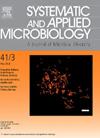Three new Microbacterium species isolated from the Marmara Sea mucilage event: Microbacterium istanbulense sp. nov., Microbacterium bandirmense sp. nov., Microbacterium marmarense sp. nov
IF 4.2
2区 生物学
Q2 BIOTECHNOLOGY & APPLIED MICROBIOLOGY
引用次数: 0
Abstract
Three bacterial strains, Mu-43T, Mu-80T, and Mu-86T, were isolated from the 2021 and 2022 mucilage event in the Marmara Sea and were taxonomically characterized. 16S rRNA gene sequence analysis confirmed that these strains belong to the genus Microbacterium. A polyphasic approach involving genomic and phenotypic analysis was employed to determine their taxonomic positions. A polyphasic approach integrating genomic and phenotypic analyses established their taxonomic positions. M. istanbulense Mu-43T showed 99.0 % 16S rRNA similarity to M. bandirmense Mu-80T, with digital DNA–DNA hybridization (dDDH) and average nucleotide identity using BLAST (ANIb) values of 22.3 % and 78.3 %, respectively. M. bandirmense Mu-80T exhibited 99.2 % similarity to M. esteraromaticum DSM 8609T, with dDDH and ANIb values of 23.6 % and 80 %. M. marmarense Mu-86T showed 97.4 % similarity to M. arthrosphaerae JCM 30492T, with dDDH and ANIb values of 20.1 % and 74.2 %. Metagenomic analysis highlighted their ecological relevance, with relative abundances of 1.43 %, 1.15 %, and 0.95 %, respectively. Further genomic analysis identified biosynthetic gene clusters associated with secondary metabolite production, including non-ribosomal peptide synthetases and terpenoid biosynthesis pathways, suggesting potential antimicrobial activity. Additionally, antibiotic resistance genes, such as ABC efflux pumps and Erm23S_rRNA methyltransferase, indicate adaptation to environmental stress. These findings indicate that these species contribute to nutrient cycling and organic matter decomposition in mucilage-affected environments. Based on genomic and phenotypic data, these strains are proposed as novel species: M. istanbulense sp. nov. Mu-43T (LMG 33297T = DSM 117065T), M. bandirmense sp. nov. Mu-80T (LMG 33295T = DSM 117210T), and M. marmarense sp. nov. Mu-86T (LMG 33293T = DSM 117066T).
从马尔马拉海黏液事件中分离到的3个新微细菌种:伊斯坦布尔微细菌、带边微细菌、马尔马拉微细菌
从2021年和2022年马尔马拉海黏液事件中分离到3株菌株Mu-43T、Mu-80T和Mu-86T,并对其进行了分类鉴定。16S rRNA基因序列分析证实这些菌株属于微杆菌属。采用包括基因组和表型分析的多相方法来确定它们的分类位置。结合基因组和表型分析的多相方法确定了它们的分类位置。M. istanbulense Mu-43T与M. bandirmense Mu-80T的16S rRNA相似性为99.0%,数字DNA-DNA杂交(dDDH)和BLAST (ANIb)平均核苷酸同源性分别为22.3%和78.3%。M. bandirmense Mu-80T与M. esteraromaticum DSM 8609T的相似性为99.2%,dDDH和ANIb值分别为23.6%和80%。M. marmarense Mu-86T与M. arthrosphaerae JCM 30492T的相似性为97.4%,dDDH和ANIb值分别为20.1%和74.2%。宏基因组分析显示,它们的相对丰度分别为1.43%、1.15%和0.95%。进一步的基因组分析确定了与次生代谢物产生相关的生物合成基因簇,包括非核糖体肽合成酶和萜类生物合成途径,提示潜在的抗菌活性。此外,抗生素抗性基因,如ABC外排泵和Erm23S_rRNA甲基转移酶,表明对环境胁迫的适应。这些发现表明,这些物种有助于在受粘液影响的环境中进行养分循环和有机物分解。根据基因组和表型数据,这些菌株被认为是新种:M. istanbulense sp. nov. Mu-43T (LMG 33297T = DSM 117065T)、M. bandirmense sp. nov. Mu-80T (LMG 33295T = DSM 117210T)和M. marmarense sp. nov. Mu-86T (LMG 33293T = DSM 117066T)。
本文章由计算机程序翻译,如有差异,请以英文原文为准。
求助全文
约1分钟内获得全文
求助全文
来源期刊

Systematic and applied microbiology
生物-生物工程与应用微生物
CiteScore
7.50
自引率
5.90%
发文量
57
审稿时长
22 days
期刊介绍:
Systematic and Applied Microbiology deals with various aspects of microbial diversity and systematics of prokaryotes. It focuses on Bacteria and Archaea; eukaryotic microorganisms will only be considered in rare cases. The journal perceives a broad understanding of microbial diversity and encourages the submission of manuscripts from the following branches of microbiology:
 求助内容:
求助内容: 应助结果提醒方式:
应助结果提醒方式:


